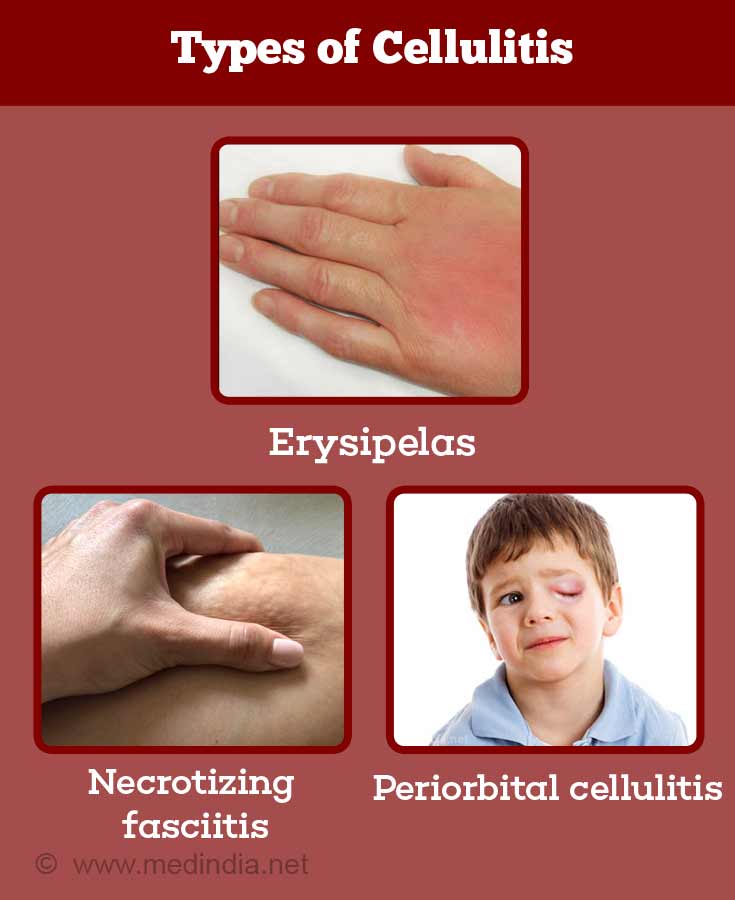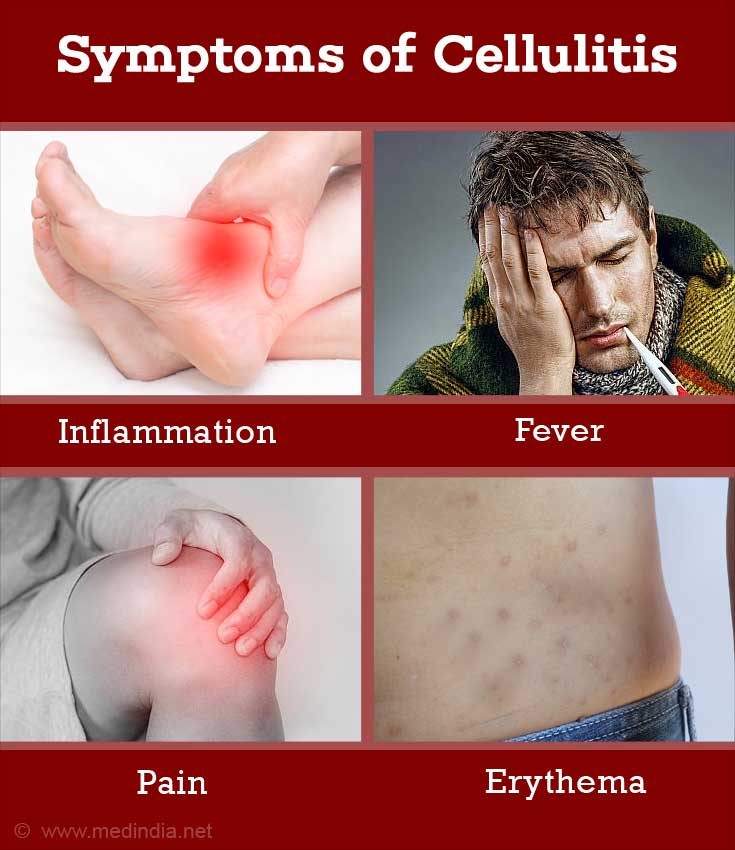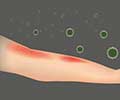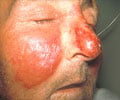- Cellulitis - (https://www.ncbi.nlm.nih.gov/books/nbk549770/)
- Cellulitis Diagnosis - (https://www.aao.org/eye-health/diseases/what-is-cellulitis)
- About Cellulitis - (https://www.health.harvard.edu/a_to_z/cellulitis-a-to-z)
- Cellulitis - Causes, Symptoms - (https://www.healthdirect.gov.au/cellulitis)
- Cellulitis - Exams And Tests - (https://medlineplus.gov/ency/article/000855.htm)
About
Cellulitis is an inflammation of the skin and the related subcutaneous tissues, resulting in swelling, redness, pain, and warmth at the site of infection. Muscles are not affected by this condition. Cellulitis is a common bacterial infection of the skin. Bacteria such as Staphylococci or Streptococci are responsible for the infection that may either remain on the surface of the skin or spread deeper into the tissues below the skin, lymph nodes, and the bloodstream. Occasionally, a fungus may be the cause of the infection.
Cellulitis may prevail as a mild infection that lasts for a few days to several weeks. In non-purulent cellulitis, there is no abscess formation, ulcer formation, or pus secretion (purulent drainage). However, in certain cases, cellulitis progresses to a severe condition leading to sepsis in the body. Purulent cellulitis, often caused by Staphylococcus aureus, results in the formation of ulcers and abscesses. If timely treatment is not provided, the infection could turn fatal. Cellulitis of the lower leg is more common compared to cellulitis of the other organs, such as hands, feet, and the groin.(1✔ ✔Trusted Source
Cellulitis
Go to source)
The different forms of Cellulitis are:
1) Erysipelas, where individuals display red patches on the skin that is most often caused by Streptococcus bacteria. The red patches are separated from the skin base by a gas bubble. Individuals experience fever for a couple of days before the onset of the rash.
2) Necrotizing fasciitis causes infection below the skin and is very severe. This condition is also known as the ‘flesh-eating disease’. Group A Streptococcus randomly infects the skin causing the infection. Another way of acquiring necrotizing fasciitis is by an aggregate microbial infection of a wounded area near a rectal abscess or the anus, following a surgery. The risk of developing necrotizing fasciitis is very small unless the individual has a weak immune system or has an infection.(2✔ ✔Trusted Source
About Cellulitis
Go to source)
3) Periorbital cellulitis causes a painful and itchy infection around the sockets of the eyes. When the bacteria infect the point where the eye attaches to the socket, it is known as orbital cellulitis. Individuals experience fever and reduced vision. Immediate action is required to prevent the development of meningitis or vision damage.
Bacteria that cause cellulitis of the skin, can invade the lymphatic system and affect other parts of the body by traveling below the skin. Red lines are observed in such cases before the spread of the infection. Individuals may experience nausea, fever, and perspiration.
Individuals with a compromised immune system, edema, or diabetes are prone to cellulitis and are likely to suffer a relapse. Infants and seniors suffer more often from cellulitis of the face. Approximately 1 out of 12 children, who suffer from facial cellulitis, develop meningitis. This occurs when the bacteria invade the central nervous system through the eye socket.

Causes of Cellulitis
Bacteria (eg, Staphylococci, Streptococci) cause cellulitis. There are many bacteria on the skin surface, which thrive if they gain entry below the surface of the skin. The bacteria, infecting the wound, are based on the nature and the condition in which the wound develops. The conditions that cause skin abrasions such as wounds (scratches, cuts, burns, bruises, peeling skin or cracks in the feet), surgery, ulcers, dermatitis, tattoo piercing, psoriasis, eczema, and athlete’s foot, result in cellulitis. Bite wounds of animals, insects, or humans also lead to cellulitis. Dental treatment can also cause cellulitis. Besides skin injuries, individuals with a weak immune system are at risk of developing cellulitis. Individuals, who are alcoholics, diabetic, or use corticosteroids, are also prone to developing cellulitis. Individuals suffering from cancer, and chronic diseases of the liver and lung are also prone to developing cellulitis.(3✔ ✔Trusted Source
Cellulitis - Causes, Symptoms
Go to source)
Symptoms of Cellulitis
The main symptoms of cellulitis are:
- Swelling or inflammation that develops with the progression of the infection
- Fever
- Pain
- Erythema and
- Warmth (the inflammation is red and hot)
- Skin becomes taut with a shiny appearance
- Rapid development of a rash in the initial 24 hours of the infection

Some of the signs of infection are fever, chills, sweating, aching muscles, and exhaustion. In addition, nausea, vomiting, hair loss at the infection site, and stiffness in joints, are the other symptoms that are observed.
Streptococci and Staphylococci cause mild infections in the skin. There are no abscesses, trauma, or underlying secretions in mild infections. Serious infections are caused by Streptococcus pneumoniae or Vibrio vulnificus. Blisters of violet coloration are indication of a serious infection. The symptoms for severe infection include, intensive pain, red streaks moving away from the site of infection, fever, and chills.
Individuals with necrotizing fasciitis develop a red, painful swelling that turns purple, and eventually black as the cells of the skin and tissue start to degrade.
Surgical intervention is necessary when the following symptoms are observed:
- Hemorrhage in the skin
- Blisters of violet coloration
- Presence of gas in the tissue
- Shedding of skin
- Anesthesia of skin
- Quick progression of the disease
Diagnosis of Cellulitis
Doctors can diagnose cellulitis based on the appearance of the skin. A physical exam is conducted to examine the nature of the swelling. The doctor marks the area of the swelling and redness to observe if there is a spread in the redness in the next few days. The doctor also examines the lymph glands to identify an infection. Only if there is an open wound or the secretion of pus, one is able to identify the causative organism with a culture test. Other recommended tests are a complete blood cell count and a blood culture test.(4✔ ✔Trusted Source
Cellulitis - Exams And Tests
Go to source, 5✔ ✔Trusted Source
Cellulitis Diagnosis
Go to source)
Treatment of Cellulitis
Most cases of cellulitis can be treated with oral antibiotics. The type of antibiotic depends on the type and severity of the infection. Cellulitis starts to decrease and disappear with the intake of antibiotics. However, despite the disappearance, one must complete the entire antibiotic course to ensure complete removal of the infection. Normally, a treatment course of 7 to 10 days is sufficient to treat cellulitis. However, longer treatment regimens may be required if the infection is persistent. This occurs when individuals have a health condition like diabetes or cancer, where the immune system is compromised. Such individuals may need to be hospitalized.

Doctors recommend rest to individuals who start the antibiotic course until the fever subsides. Once the fever subsides and the infection reduces, individuals may resume their normal activity. Warm compresses improve the flow of blood to fight the infection. Raising the infected area above the heart is also another method of reducing the pain and inflammation.
Individuals that are infected with methicillin-resistant Staphylococus aureus (MRSA), are prescribed MRSA-specific antibiotics.
In the case of necrotizing fasciitis, antibiotics may not be effective in controlling the infection especially when the flesh starts to degrade. Hence, amputation is recommended to prevent further spread of the infection.
Individuals may need to be hospitalized if the infection worsens despite antibiotic treatment. Individuals who have persistent fever, vomiting or nausea, or require intravenous antibiotic treatment also require to be hospitalized.(1✔ ✔Trusted Source
Cellulitis
Go to source)
How to Avoid Cellulitis
One can avoid cellulitis by taking the following precautions:
- Always cover hands and legs when going on hikes. This avoids scratches and cuts on the skin.
- Always Clean skin with a mild soap.
- Change bandages each day.
- Avoid swimming with cracked skin.
- Wear protective gear when playing outdoor sports.
- Avoid walking outside with bare feet.
- Consult a doctor for large wounds or bites.(1✔ ✔Trusted Source
Cellulitis
Go to source)















